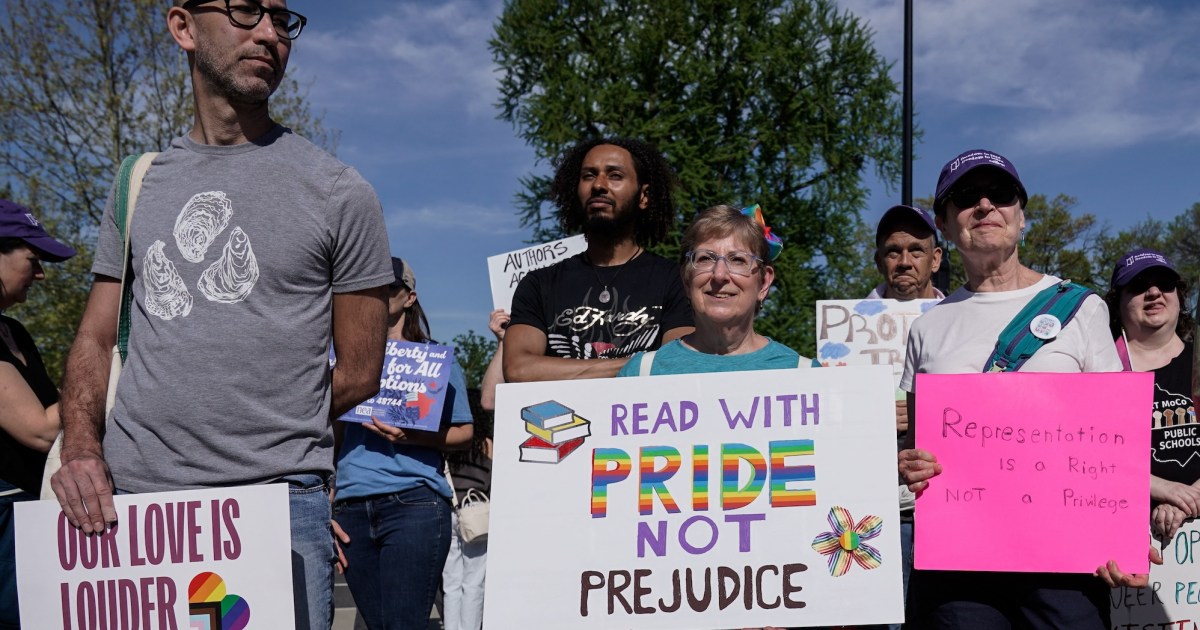On Tuesday, a group of religious parents had their day at the Supreme Court, hoping the justices would grant them something extraordinary: the ability to pull their kids out of a classroom whenever instruction verges into territory that contradicts their religious beliefs. Based on the justices’ responses in oral arguments, those parents are very likely to win the day—and public education may never be the same.
The case, Mahmoud v. Taylor, came out of Montgomery County, Maryland, where a group of Christian and Muslim parents, represented by the Becket Fund for Religious Liberty, a Christian legal advocacy firm, are suing the the county board of education for the ability to pull their kids from the classroom when certain books with LGBTQ content are read. While the attorney representing the parents was careful to say that they could never dictate what was taught—they simply want the option to opt out—that’s not where such a demand leads.
A classroom where kids will be escorted out every time information about an LGBTQ person or subject comes up is one in which, ultimately, those subjects will be suppressed. The few parents who want to shield their children from knowledge about LGBTQ people may go a long way toward eradicating the idea of their existence from American classrooms. We know this opt-out route doesn’t work because the school district already tried it three years ago —and, as my colleague Sarah Szilagy explains, it failed.
During oral arguments, Justice Neil Gorsuch raised the possibility that the Montgomery County Board of Education didn’t actually end the policy because of infeasibility, but because of animus.
“We have some statements from Board members suggesting,” Gorsuch said, quoting the parents’ brief, “that some parents might be promoting hate and suggesting that it was unfortunate that they were taking a view endorsed by white supremacists and xenophobes.” Based on these comments (which the board’s lawyer said were intemperate, but taken out of context), Gorsuch pressed, why shouldn’t the court treat this as a religious discrimination case? And, he implied, why shouldn’t the court side with the parents on those grounds?
Gorsuch’s question is worth turning on the court itself. When a majority rules in June, as it almost certainly will, that religious parents can pull their kids out of a classroom whenever a book or lesson contradicts their religious beliefs, it will be fair to ask whether those justices applied the law neutrally, or whether they acted out of religious animus against LGBTQ people: whether their own disinclination to view LGBTQ people and their lives in a positive light led them to attempt to banish such views from public school classrooms.
Justice Amy Coney Barrett, for example, was dismayed that a teacher might explain “transgenderism” according to instructional material that read, as she quoted: “When we’re born, people make a guess about our gender and label us boy or girl based on our body parts. Sometimes they’re right; sometimes they’re wrong. When someone’s transgender, they guess wrong. When someone’s cisgender, they guessed right.” Barrett called that more about “influence” than “communicating respect”; if so, how does Barrett think teachers should define being transgender?
Consider this wild hypothetical from Justice Samuel Alito, in which he describes a completely unrealistic scenario about how tolerance of LGBTQ people could be weaponized to attack Catholics like himself:
Suppose a school says we’re going to talk about same-sex marriage and same-sex marriage is legal in Maryland and it’s a good thing, it’s moral, it makes people happy, same-sex couples form good families, they raise children. Now, there are those who disagree with that. Catholics, for example, they disagree with that. They think that it’s not moral, but they’re wrong and they’re bad and anybody who doesn’t accept that same-sex marriage is normal and just as good as opposite-sex marriage is not a good person.
Alan Schoenfeld, the attorney who represented the county board of education, said that would be coercion. But the example demonstrated Alito’s long-held belief that LGBTQ rights are actually a vehicle for attacks on religious people like himself.
Then there’s this (lightly edited) exchange between Alito and Schoenfeld, in which Alito grows increasingly upset at the idea that children should hear a positive portrayal of two men getting married, as happens in one of the books raised in the case, Uncle Bobby’s Wedding. Like Barrett, Alito argued that a positive portrayal of an LGBTQ issue is intrinsically coercive. The back-and-forth gets at the key question in the case: Is exposure to a fact or idea a burden or form of coercion on religious expression?
Alito: Exposure is telling the students that there are a lot of people who marry a person of the opposite sex, there are also people who marry a person of the same sex. Period. Leave it at that. That’s exposure. If you go beyond that, is it still exposure?
Schoenfeld: It depends on the context. I mean, I think Uncle Bobby’s Wedding is teaching third graders or second graders precisely that. It’s telling it through a story.
Alito: I think it clearly goes beyond that. It doesn’t just say that Uncle Bobby and Jamie are getting married. It expresses the idea subtly, but it expresses the idea this is a good thing. “Mommy, said Chloe, I don’t understand, why is Uncle Bobby getting married. Bobby and Jamie love each other, said Mommy. When grownup people love each other that much, sometimes they get married.” I mean, that’s not sending—subtly sending the message this is a good thing?
Schoenfeld: I think that’s a way of a mother consoling her daughter who’s annoyed that they are favorite uncle is distracted and doesn’t have time for her. But even if the message were some people are gay, some people
get married, I don’t think there’s anything impermissibly normative about that. It is a story that is being used to teach students that, just as in the 99 of the 100 books that we read about couples, it’s a man and a woman, there also may be a man and a man.Alito: Why is the Montgomery County Board of Education in this argument running away from what they clearly want to say? They have a view that they want to express on these subjects. And maybe it’s a very good view, but they have a definite view. And that’s the whole point of this curriculum; is it not?
Schoenfeld: I think what’s in the record is that the Board wants to teach civility and respect for difference in the classroom. There is obviously an incidental message in some of these books that these life choices and these life styles are worthy of respect. I don’t know how you can teach students to respect each other without teaching that… So the incidental message that these things ought to be normalized and treated with respect, I think, is simply part of the work that the school is doing in cultivating respect in a pluralistic school.
Alito: Well, the plaintiffs here are not asking the school to change its curriculum. They’re just saying, look, we want out. Why isn’t that feasible? What is the big deal about allowing them to opt out of this?
Schoenfeld: I think on the facts of this case, we have the natural experiment of the school’s permitting these opt-outs and then finding that it was not administrable.
Alito: Well, why is it not administrable?
The debate went on, with Justice Brett Kavanaugh jumping in to claim that if schools can set up an alternative health class—a single discrete class where an alternative is mandated by the state, and therefore prepped in advance—then surely they could do it for parents who don’t want their kids exposed to Uncle Bobby’s Wedding. Schoenfeld took one last stab at trying to explain the problem:
If you think about the way a third-grade classroom operates and you think about the fact that there are some students sitting in the corner, and they say: This is a great book, I’m going to take it off the shelf, and three and then five and then nine students gather around to read it, and they say: Teacher, I want you to come over and watch us doing that. All of those things, I think, fall within the definition of “curriculum” at that lower grade.
It’s mayhem. And the ability of teachers to manage the line between what is
curriculum content coming directly from the teacher and coming indirectly from the sort of socialization in the classroom, I think, is very hard to draw.
Kavanaugh and Barrett, whose kids are still young, must know this. Alito and the other Republican-appointed justices surely do as well. But the infeasibility is really the point. If you can’t actually accommodate some parent’s opt-out requests, then the religious beliefs of those parents begin to dictate what is discussed in the classroom. If you can’t feasibly remove students every time a book is opened, or every time a student raises their hand to ask what transgender means, then that content is ultimately silenced, and with it the idea that LGBTQ people exist, much less are normal and deserving of respect. It’s why some commenters have taken to calling this the “Don’t Say Gay” case—because that’s where it leads.
Justice Ketanji Brown Jackson even got the Justice Department’s Sarah Harris, who argued for the Trump administration in support of the parents, to admit that the ramifications could travel beyond the classroom. “There are obviously going to be contexts besides the school context in which we would agree that there is a burden,” she said.
The question isn’t who will win the case, but how big a win it will be. If Gorsuch’s logic about animus on the Board of Education prevails, then the ruling could apply just to Montgomery County schools. But if the view is adopted that exposure to the idea that it’s okay for men to marry men is now a violation of the Free Exercise Clause, then public education across the country could change dramatically.
If so, it will be only logical to wonder whether exposure to the idea of a socially accepted gay couple is deemed unconstitutional because parents’ religious rights have been violated—or because the justices’ own inability to accept LGBTQ people has prevailed.














